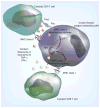Cytolytic CD4(+) T cells in viral immunity
- PMID: 21105780
- PMCID: PMC3033049
- DOI: 10.1586/erv.10.132
Cytolytic CD4(+) T cells in viral immunity
Abstract
It is generally believed that the role of CD4(+) T cells is to coordinate the different arms of the adaptive immune system to shape an effective response against a pathogen and regulate nonessential or deleterious activities. However, a growing body of evidence suggests that effector CD4(+) T cells can directly display potent antiviral activity themselves. The presence of cytolytic CD4(+) T cells has been demonstrated in the immune response to numerous viral infections in both humans and in animal models and it is likely that they play a critical role in the control of viral replication in vivo. This article describes the current research on virus-specific cytolytic CD4(+) T cells, with a focus on HIV-1 infection and the implications that this immune response has for vaccine design.
Figures


Similar articles
-
Cooperativity of HIV-Specific Cytolytic CD4 T Cells and CD8 T Cells in Control of HIV Viremia.J Virol. 2015 Aug;89(15):7494-505. doi: 10.1128/JVI.00438-15. Epub 2015 May 13. J Virol. 2015. PMID: 25972560 Free PMC article.
-
Cytotoxic CD4+ T-cells during HIV infection: Targets or weapons?J Clin Virol. 2019 Oct;119:17-23. doi: 10.1016/j.jcv.2019.08.004. Epub 2019 Aug 16. J Clin Virol. 2019. PMID: 31445411 Review.
-
Mechanisms of Antiviral Cytotoxic CD4 T Cell Differentiation.J Virol. 2021 Sep 9;95(19):e0056621. doi: 10.1128/JVI.00566-21. Epub 2021 Jul 14. J Virol. 2021. PMID: 34260270 Free PMC article.
-
Cytolytic CD4 cells: Direct mediators in infectious disease and malignancy.Cell Immunol. 2010;262(2):89-95. doi: 10.1016/j.cellimm.2010.02.008. Epub 2010 Feb 24. Cell Immunol. 2010. PMID: 20236628 Free PMC article. Review.
-
An HIV-1 envelope protein vaccine elicits a functionally complex human CD4+ T cell response that includes cytolytic T lymphocytes.J Immunol. 1993 May 15;150(10):4672-86. J Immunol. 1993. PMID: 8097759
Cited by
-
Synaptic Interactions in Germinal Centers.Front Immunol. 2018 Aug 13;9:1858. doi: 10.3389/fimmu.2018.01858. eCollection 2018. Front Immunol. 2018. PMID: 30150988 Free PMC article. Review.
-
Mucosal immunology of HIV infection.Immunol Rev. 2013 Jul;254(1):10-33. doi: 10.1111/imr.12072. Immunol Rev. 2013. PMID: 23772612 Free PMC article. Review.
-
CMV exposure drives long-term CD57+ CD4 memory T-cell inflation following allogeneic stem cell transplant.Blood. 2021 Dec 30;138(26):2874-2885. doi: 10.1182/blood.2020009492. Blood. 2021. PMID: 34115118 Free PMC article.
-
Cooperativity of HIV-Specific Cytolytic CD4 T Cells and CD8 T Cells in Control of HIV Viremia.J Virol. 2015 Aug;89(15):7494-505. doi: 10.1128/JVI.00438-15. Epub 2015 May 13. J Virol. 2015. PMID: 25972560 Free PMC article.
-
DNA immunization site determines the level of gene expression and the magnitude, but not the type of the induced immune response.PLoS One. 2018 Jun 4;13(6):e0197902. doi: 10.1371/journal.pone.0197902. eCollection 2018. PLoS One. 2018. PMID: 29864114 Free PMC article.
References
-
- Claman HN, Chaperon EA. Immunologic complementation between thymus and marrow cells – a model for the two-cell theory of immunocompetence. Transplant Rev. 1969;1:92–113. - PubMed
-
- Geha RS, Schneeberger E, Rosen FS, Merler E. Interaction of human thymus-derived and non-thymus-derived lymphocytes in vitro. Induction of proliferation and antibody synthesis in B lymphocytes by a soluble factor released from antigen-stimulated T lymphocytes. J Exp Med. 1973;138(5):1230–1247. - PMC - PubMed
-
- Reinherz EL, Schlossman SF. The differentiation and function of human T lymphocytes. Cell. 1980;19(4):821–827. - PubMed
Publication types
MeSH terms
Grants and funding
LinkOut - more resources
Full Text Sources
Other Literature Sources
Medical
Research Materials
